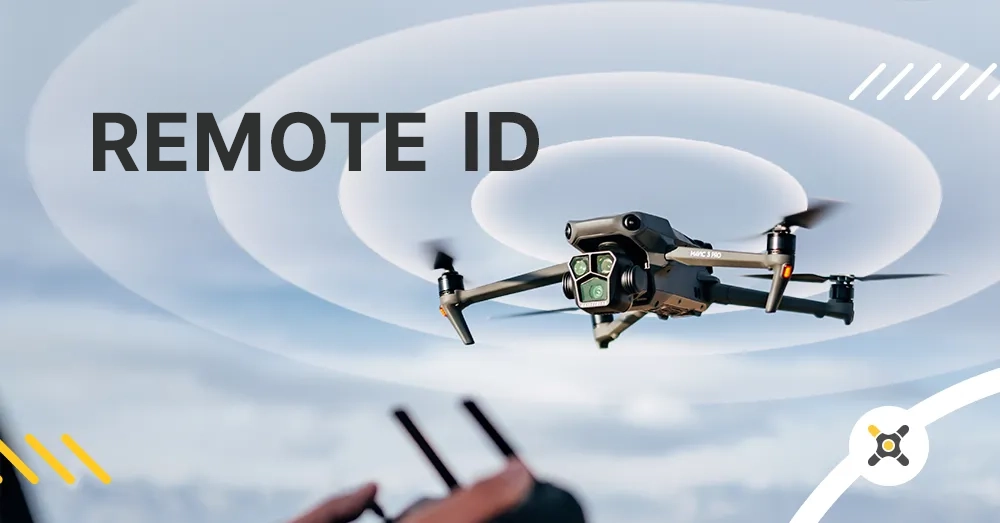Remode ID - everything you need to know

Many people are wondering how to fly legally. The Internet is full of conflicting and outdated information, which can be confusing for new users. Therefore, we decided to write this article to help you understand the most important regulations on remote drone identification (Remote ID). With our guidance, you will learn who must comply with Remote ID requirements, how the system works, and what are the exceptions to these regulations.
Where did the Remote ID requirements come from?
Requirements for remote identification of drones come from EU Regulation 2019/947/EU. Although the legal framework is set at the European level, individual member states have the opportunity to tailor regulations to their needs. In Poland, we have national NSTS scenarios, which are valid until 2026.
What is Remote ID and how it works?

Remote ID, or remote identification, is an advanced system that allows information about a drone and its operator to be transmitted remotely. This system allows you to get detailed data about your drone without having to physically access it. This is a key solution for safety and transparency of drone flights. Remote identification works by broadcasting data from an unmanned aerial vehicle (BSP) to mobile devices within range. This allows those in the vicinity and relevant services to monitor the drone's activity in real time. This system sends the following information:
- Drone operator registration number: Each drone operator must be registered, and his registration number is one of the basic data sent by the system.
- Drone serial number: A unique identification number for the drone that allows it to be uniquely identified.
- Time, location and altitude of the drone: Up-to-date information about the drone's location, altitude and time, allowing you to track its route in real time.
- Drone route and speed: Direction and speed data, which is hugely important for air traffic monitoring.
- The location of the pilot or launch point of the drone: Information about the location from which the drone is controlled, which is important for emergency interventions.
- Emergency status of the drone: Information on possible technical problems or failures that may affect flight safety.
Remote ID is being introduced primarily to enhance security in the airspace. With this system, it is possible to react more quickly to potential threats, identify drones flying in unauthorized areas, and monitor compliance with regulations. The introduction of Remote ID is also aimed at building trust among the public, that drones are used responsibly and in accordance with the law.
Who does and does not need to have a Remote ID?

When Remote ID went into effect, many people had doubts about who had to comply with the new requirements. We now know that as a user of drones marked with the class, you can rest assured. If the drone has a class, it automatically meets the requirements of Remote ID, because it is a classification requirement. Similarly, those with unclassified drones that were launched before January 1, 2024, need not worry about these regulations.
There is no requirement to have a Remote ID for:
- Privately built drones: Drones constructed for private use to be operated in the subcategory A1 (weight less than 250 g and maximum speed less than 19 m/s) or A3 (weight less than 25 kg).
- Drones in the open category: Drones designated as class C0 or C4, as well as drones that are not marked with classes but were put on the market before January 1, 2024. and will be operated in subcategories A1 (weight less than 250 g) or A3 (weight less than 25 kg).
- Drones in the special category: By December 31, 2025. drones flying in this category are not required to have Remote ID unless they are already equipped with it.
- Other drones: Tethered drones designated as class C3, C5 or C6 are also exempt from the Remote ID requirement.
Who is required to have a Remote ID:
The obligation to have Remote ID mainly applies to drones released after 2024 that do not have an assigned class. In practice, there are few such drones, and our store does not sell them, so this mainly applies to cheap models from uncertain sources. In addition, drones under 250 grams that are not assigned a class and do not have a speed limit of 19 m/s must also meet these requirements.
It is worth noting that "marketing" means the premiere of a given product on the market, and not the model's production date. For the special category, the situation will change after December 31, 2025., when the current NSTS scenarios expire and are replaced by STS, which require Remote IDs. There are companies that produce Remote ID systems, so if you have a drone that requires such equipment, you can make the appropriate installation.
Summary
Remote ID is a remote drone identification system, which aims to increase safety in the airspace. If you want to fly a drone legally, it's worth knowing the current regulations on Remote ID. Remember that drones marked with the class and those launched before January 1, 2024. in many cases do not require this system. For a complete list of recommended Remote ID systems accepted by EASA and EU law, see here.

